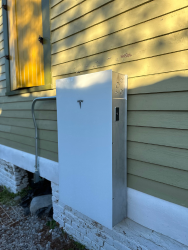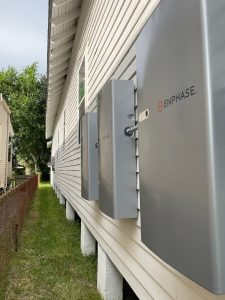Solar batteries are warranted to provide reliable power for up to 15 years with the possibility to continue providing practical energy storage beyond that. Battery lifespan varies based on system design, usage patterns, and environmental conditions.
 Understanding the Lifespan of a Battery
Understanding the Lifespan of a BatteryInvesting in solar batteries ensures energy independence and backup power when needed most. But how long do they actually last? Understanding battery lifespan helps homeowners plan for long-term savings and uninterrupted power.
From battery type to usage patterns, environmental conditions, and warranties, each element plays a role in determining the lifespan of a solar battery.
Not all solar batteries are created equal. The type of battery installed plays a major role in its lifespan, efficiency, and maintenance needs.
Lithium-ion batteries have become the gold standard for home solar storage, offering high efficiency, deep discharge capabilities, and a lifespan of 10–15 years with little to no maintenance.
On the other hand, lead-acid batteries, common in legacy and specialty systems, require more complex installation and generally have a shorter lifespan. They are more affordable upfront but degrade faster, especially if discharged too deeply or too often, and generally have a working life of 5-7 years.
There are two main types of lithium-ion batteries used in solar energy storage: Lithium Iron Phosphate (LFP) and Nickel Manganese Cobalt (NMC).
Both types provide excellent efficiency and deep discharge capabilities, but LFP batteries are often preferred for home energy storage due to their longer lifespan and enhanced safety.
Flow batteries are an emerging technology boasting an impressive 15–25-year lifespan. These don’t degrade as quickly, but their large size and high cost have made them less common for residential use.
Each complete battery charge and discharge represents one cycle. Over time, batteries gradually hold less charge, much like how an older cell phone battery doesn’t last as long as when it was new. Lithium-ion batteries typically have a cycle life of 4,000–6,000 cycles, which translates to 10–15 years of average daily use. Understanding cycle life helps predict battery replacement timing. A battery cycled once daily might reach its end of life sooner than one used primarily for backup, even if both batteries were installed at the same time. Most solar batteries come with a 10-year limited warranty, and typically guarantee at least 70% capacity retention. These warranties often specify protection for either a time period or a number of cycles (typically 4,000-6,000 cycles), whichever comes first.
Batteries wear down over time due to charge and discharge cycles. Depth of Discharge refers to how much of the battery’s capacity is used before recharging. Lithium-ion batteries have a DoD of 80–95%, allowing for deeper energy use without shortening lifespan. The relationship between DoD and battery life is important: deeper discharges generally lead to shorter overall lifespan. Most residential systems are programmed to operate within optimal DoD ranges to balance performance and longevity. The more a battery is fully discharged, the faster it degrades, so selecting a battery with a high cycle life and appropriate DoD ensures better longevity.
Like any other technology, batteries experience natural wear from regular use and these usage patterns significantly impact battery longevity. Batteries that cycle daily tend to wear out faster than those reserved for backup power. Backup-only systems, which activate only during power outages, last significantly longer because they go through fewer cycles. Homeowners looking for long-term storage should consider their daily energy consumption and backup needs when choosing the right battery capacity.
A solar battery’s performance isn’t just about technology—it’s also about where and how it’s stored. Extreme heat accelerates the chemical reaction within the battery and causes aging, while cold temperatures can temporarily reduce capacity. Homeowners can maximize battery life by installing them in an environment that maintains moderate temperatures, like a climate-controlled garage.
Modern solar batteries are designed to be low-maintenance, making them easy to manage. Lithium-ion batteries require very little upkeep—most homeowners simply monitor their performance using an app to ensure everything is functioning optimally.
Most solar battery warranties guarantee either 10 years or a set number of cycles (typically 4,000-6,000), whichever comes first. This means a battery cycled daily may reach its warranty limit before the 10-year mark, while a backup-only battery could last much longer. Most warranties also include capacity retention, ensuring the battery maintains 70–80% of its original storage capacity after 10 years.
 How Long Do Solar Batteries Last Compared to Solar Panels?
How Long Do Solar Batteries Last Compared to Solar Panels?Solar panels last 25–30 years, significantly longer than most batteries. Since solar batteries typically last 5–15 years, homeowners should plan for at least one battery replacement over the lifespan of their solar system.
During a power outage, a standard battery system typically provides 10-24 hours of backup power for essential items like refrigeration, lighting, and basic electronics. The exact duration depends on:
The number of batteries required depends on energy consumption and storage goals. A single 10–15 kWh lithium-ion battery can power essential household items like refrigerators, lighting, and electronic devices. For whole-home backup, 2–3 batteries totaling 30–40 kWh may be necessary, particularly for larger homes with higher energy demands. A professional energy assessment can help determine the best battery setup for long-term reliability.
Modern solar batteries provide dependable home energy storage for years when properly installed and maintained. Investing in the right solar battery will give homeowners reliable energy storage, savings on their energy bills, and more energy independence. Lithium-ion technology provides a balance of efficiency, longevity, and low maintenance—making it the top choice for homeowners seeking energy security.
Solar Alternatives engineers design independent energy systems specifically for homes and businesses in the Gulf Coast. To explore the best solar battery solutions for your home or business, schedule a consultation with a solar professional today and take the next step toward independent power.
Get Started With A Free Quote Today